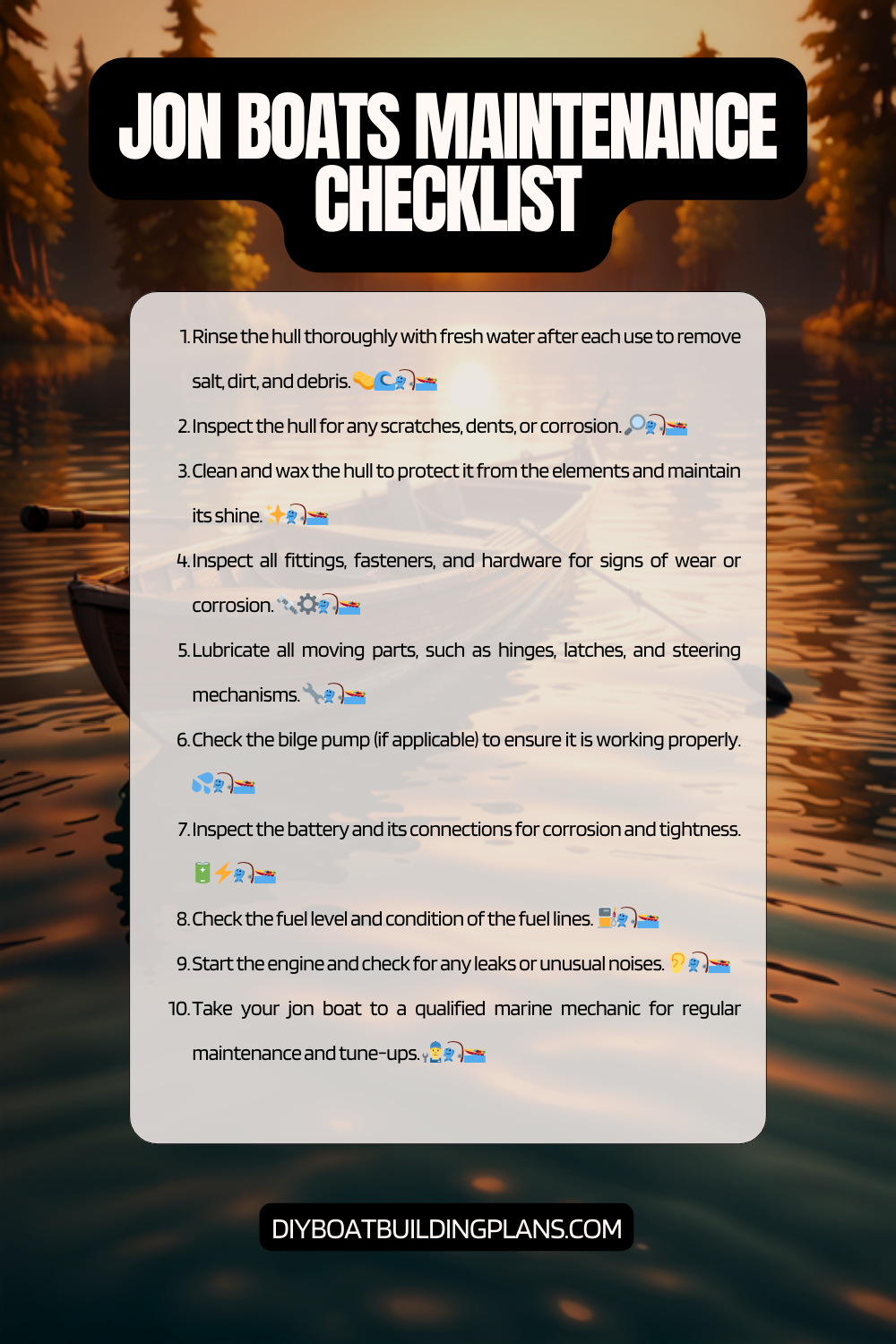Overview of Jon Boat Maintenance Tips
Jon boats are versatile and popular watercraft that are commonly used for fishing and hunting in shallow waters. These boats are characterized by their flat-bottomed design, which allows them to navigate through narrow and shallow waterways with ease. Jon boats are typically made of aluminum or fiberglass, making them lightweight and durable. They come in various sizes, ranging from 10 to 20 feet in length, and can accommodate one or more passengers.
There are different types of Jon boats available in the market, each designed for specific purposes. The standard Jon boat is the most common type, featuring a flat-bottomed hull and a bench seat. Modified Jon boats have a slightly V-shaped hull, which provides better stability and maneuverability. They often come with a center console or a casting deck for added convenience. Jet Jon boats are equipped with a jet drive system instead of a traditional propeller, allowing them to operate in extremely shallow waters.
Jon boats have a wide range of uses, making them popular among outdoor enthusiasts. They are commonly used for fishing in lakes, rivers, and ponds, as their flat-bottomed design allows them to access hard-to-reach fishing spots. Jon boats are also favored by hunters for navigating through marshes and swamps during waterfowl hunting season. Additionally, these boats can be used for recreational activities such as cruising, camping, and wildlife observation.
Key Takeaways
- Regular maintenance is crucial for keeping your Jon Boat in good condition and ensuring safety on the water.
- Cleaning the exterior and interior of your Jon Boat, checking and replacing the battery, lubricating moving parts, inspecting and repairing the hull, and maintaining the motor and propeller are all important maintenance tasks.
- Properly storing your Jon Boat when not in use can also help prolong its lifespan.
- Safety should always be a top priority when performing maintenance on your Jon Boat.
- By following these maintenance tips, you can keep your Jon Boat in great shape and enjoy many years of safe and fun boating.

Importance of Regular Maintenance
Regular maintenance is crucial for keeping your Jon boat in optimal condition and ensuring its longevity. By taking care of your boat on a regular basis, you can prevent costly repairs and extend its lifespan. Neglecting maintenance can lead to various consequences that can affect the performance and safety of your boat.
One of the benefits of regular maintenance is that it helps identify potential issues before they become major problems. By inspecting your boat regularly, you can catch any signs of wear and tear, corrosion, or damage early on. This allows you to address these issues promptly and prevent them from escalating into more serious and expensive repairs.
On the other hand, neglecting maintenance can result in a range of consequences. For instance, failing to clean the exterior of your boat can lead to the buildup of dirt, grime, and algae, which can affect its performance and fuel efficiency. Ignoring the maintenance of moving parts can cause them to become stiff or corroded, leading to poor performance and potential breakdowns. Neglecting the hull can result in damage that compromises the structural integrity of the boat, making it unsafe to use.
Cleaning the Exterior of Your Jon Boat
Cleaning the exterior of your Jon boat is an essential part of regular maintenance. It not only keeps your boat looking good but also helps maintain its performance and durability. Here are the materials needed and steps to follow for cleaning the exterior of your Jon boat:
Materials Needed for Cleaning:
– Mild detergent or boat soap
– Soft-bristle brush or sponge
– Hose or pressure washer
– Bucket
– Microfiber towels or chamois
Steps for Cleaning the Exterior:
1. Rinse the boat with water to remove loose dirt and debris.
2. Fill a bucket with water and add a small amount of mild detergent or boat soap.
3. Dip the soft-bristle brush or sponge into the soapy water and scrub the entire exterior of the boat, including the hull, deck, and any other surfaces.
4. Pay special attention to areas with stubborn stains or algae growth.
5. Rinse off the soap residue using a hose or pressure washer.
6. Dry the boat thoroughly using microfiber towels or a chamois.
Tips for Maintaining the Exterior:
– Avoid using harsh chemicals or abrasive cleaners that can damage the paint or finish of your boat.
– Regularly waxing your boat can help protect its exterior from UV rays, saltwater, and other environmental factors.
– After each use, rinse your boat with freshwater to remove any salt or dirt that may have accumulated.
Maintaining the Interior of Your Jon Boat
| Task | Frequency | Time Required | Tools Required |
| Cleaning the interior | After every use | 15-30 minutes | Bucket, sponge, mild soap |
| Checking for leaks | Every 6 months | 30 minutes | Flashlight, sealant |
| Replacing damaged seats | As needed | 1-2 hours | Screwdriver, new seats |
| Inspecting electrical wiring | Every year | 1-2 hours | Multimeter, wire cutters, electrical tape |
In addition to cleaning the exterior, maintaining the interior of your Jon boat is equally important. This includes keeping the seats, flooring, storage compartments, and other interior components clean and in good condition. Here are the materials needed and steps to follow for cleaning the interior of your Jon boat:
Materials Needed for Cleaning:
– Mild detergent or boat soap
– Soft-bristle brush or sponge
– Vacuum cleaner or broom
– Microfiber towels or absorbent cloths
Steps for Cleaning the Interior:
1. Remove any loose items or debris from the interior of the boat.
2. Use a vacuum cleaner or broom to remove dust, dirt, and debris from the floor and seating areas.
3. Fill a bucket with water and add a small amount of mild detergent or boat soap.
4. Dip the soft-bristle brush or sponge into the soapy water and scrub the seats, flooring, and other interior surfaces.
5. Pay attention to any stains or spills and use appropriate cleaning products to remove them.
6. Rinse off the soap residue using a damp cloth or sponge.
7. Dry the interior thoroughly using microfiber towels or absorbent cloths.
Tips for Maintaining the Interior:
– Avoid using abrasive cleaners or brushes that can damage the upholstery or flooring.
– Regularly inspect and clean storage compartments to prevent mold, mildew, and odors.
– Consider using protective covers for seats and flooring to minimize wear and tear.
Checking and Replacing the Battery
The battery is an essential component of your Jon boat’s electrical system, powering various accessories such as lights, navigation equipment, and trolling motors. Regularly checking and maintaining your boat’s battery is crucial for ensuring its reliability and performance. Here is the importance of battery maintenance, steps for checking the battery, and tips for replacing it when necessary:
Importance of Battery Maintenance:
– A well-maintained battery ensures that your boat’s electrical system functions properly.
– Regular maintenance helps prevent battery failure, which can leave you stranded on the water.
– Proper battery maintenance extends its lifespan and saves you money on replacements.
Steps for Checking the Battery:
1. Start by visually inspecting the battery for any signs of corrosion, leaks, or damage.
2. Check the battery terminals for tightness and cleanliness. Loose or corroded terminals can affect the battery’s performance.
3. Use a voltmeter or multimeter to measure the battery’s voltage. A fully charged battery should read around 12.6 volts.
4. If the voltage is significantly lower, it may indicate a weak or discharged battery that needs to be recharged.
Tips for Replacing the Battery:
– When replacing the battery, choose a marine-grade battery that is suitable for your boat’s electrical requirements.
– Follow the manufacturer’s instructions for proper installation and connection of the new battery.
– Dispose of the old battery responsibly at a designated recycling facility.
Lubricating Moving Parts
Proper lubrication of moving parts is essential for maintaining the performance and longevity of your Jon boat. Lubrication reduces friction, prevents corrosion, and ensures smooth operation of various components. Here is the importance of lubrication, parts that need lubrication, and types of lubricants to use:
Importance of Lubrication:
– Lubrication reduces wear and tear on moving parts, extending their lifespan.
– It prevents rust and corrosion, especially in saltwater environments.
– Proper lubrication ensures smooth operation and optimal performance.
Parts that Need Lubrication:
– Steering system: Apply grease to the steering mechanism, including the steering wheel, cables, and connections.
– Trailer components: Lubricate the trailer’s wheel bearings, winch, rollers, and hinges.
– Throttle and shift controls: Apply lubricant to the control cables and pivot points.
– Propeller shaft: Use marine grease to lubricate the propeller shaft and propeller nut.
Types of Lubricants to Use:
– Marine grease: This type of grease is specifically formulated for marine applications and provides excellent water resistance.
– Silicone spray: Silicone spray is ideal for lubricating rubber seals, gaskets, and other non-metallic components.
– Penetrating oil: Penetrating oil can be used to loosen rusted or stuck parts before applying lubricant.
Inspecting and Repairing the Hull
The hull is the main structure of your Jon boat, and regular inspection and maintenance are crucial for its integrity and safety. The hull can be subject to damage from impacts, abrasion, or exposure to harsh elements. Here is the importance of hull maintenance, signs of hull damage, and steps for repairing it:
Importance of Hull Maintenance:
– A well-maintained hull ensures the structural integrity of your boat, preventing leaks or cracks.
– Regular inspection helps identify any signs of damage early on, allowing for timely repairs.
– Proper maintenance extends the lifespan of your boat and ensures its safety on the water.
Signs of Hull Damage:
– Cracks or fractures in the hull
– Soft spots or delamination
– Blisters or bubbles on the surface
– Excessive flexing or deformation
Steps for Repairing the Hull:
1. Start by thoroughly cleaning the damaged area to remove any dirt, grime, or loose material.
2. Use a grinder or sandpaper to smooth out any rough edges around the damaged area.
3. Apply a fiberglass repair kit according to the manufacturer’s instructions. This typically involves applying layers of fiberglass cloth and resin to reinforce the damaged area.
4. Allow the repair to cure completely before sanding and painting to match the rest of the hull.
Maintaining the Motor and Propeller
The motor and propeller are critical components of your Jon boat, and regular maintenance is essential for their performance and longevity. Proper maintenance ensures that your boat’s engine runs smoothly and efficiently, reducing the risk of breakdowns or damage. Here is the importance of motor and propeller maintenance, steps for maintaining them, and tips for preventing damage:
Importance of Motor and Propeller Maintenance:
– Regular maintenance ensures that your boat’s engine operates at its peak performance, providing reliable power.
– Proper maintenance reduces the risk of overheating, fuel inefficiency, or mechanical failures.
– Taking care of the propeller helps maintain its balance and prevents damage to the blades.
Steps for Maintaining the Motor and Propeller:
1. Follow the manufacturer’s recommended maintenance schedule for your boat’s engine.
2. Regularly check and change the engine oil, oil filter, fuel filter, and spark plugs.
3. Inspect the cooling system for any leaks or blockages and flush it with freshwater after each use in saltwater.
4. Grease all moving parts, such as the throttle linkage, steering mechanism, and tilt/trim assembly.
5. Inspect the propeller for any damage or bent blades. Replace it if necessary.
Tips for Preventing Motor and Propeller Damage:
– Avoid running the motor in shallow waters or areas with submerged obstacles.
– Trim up the motor when navigating through shallow waters to prevent damage to the propeller.
– Use a propeller guard if you frequently navigate in areas with underwater vegetation or debris.
Storing Your Jon Boat Properly
Proper storage is essential for protecting your Jon boat from damage caused by exposure to harsh weather conditions, UV rays, or theft. Storing your boat correctly during periods of non-use helps maintain its appearance, performance, and overall condition. Here is the importance of proper storage and tips for storing your Jon boat:
Importance of Proper Storage:
– Proper storage protects your boat from damage caused by sun, rain, snow, or extreme temperatures.
– It prevents the growth of mold, mildew, or pests that can damage the interior or electrical components.
– Storing your boat securely reduces the risk of theft or vandalism.
Tips for Storing Your Jon Boat:
– Choose a suitable storage location, such as a garage, boat shed, or covered storage facility.
– If storing outdoors, use a boat cover to protect your boat from the elements.
– Ensure that the boat is properly supported to prevent hull deformation or stress on the trailer.
– Disconnect and remove the battery to prevent drain and corrosion.
– Consider using a trailer lock or security system to deter theft.
Safety Tips for Jon Boat Maintenance
While performing maintenance on your Jon boat, it is essential to prioritize safety to prevent accidents or injuries. Here are some safety tips to keep in mind during Jon boat maintenance:
Importance of Safety:
– Safety should always be a top priority when working on or around your boat.
– Following safety guidelines reduces the risk of accidents, injuries, or damage to your boat.
– Proper safety measures ensure that you can enjoy your boating experience without any mishaps.
Safety Tips for Jon Boat Maintenance:
– Always wear appropriate personal protective equipment (PPE), such as gloves, safety glasses, and non-slip footwear.
– Use caution when working with tools or equipment to avoid injury.
– Ensure that the boat is securely supported and stable before performing any maintenance tasks.
– Follow manufacturer’s instructions and guidelines for all maintenance procedures.
– If unsure about any maintenance task, consult a professional or seek guidance from experienced boaters.
Download over 500 Boat Plans. Click on the link below.
-->Click Here<--
Jon Boat Maintenance Checklist

Conclusion – Jon Boat Maintenance Tips
In conclusion, regular maintenance is crucial for keeping your Jon boat in optimal condition and ensuring its longevity. By following the maintenance tips outlined in this article, you can keep your boat clean, well-maintained, and safe for your next adventure on the water. Remember to regularly clean the exterior and interior, check and replace the battery, lubricate moving parts, inspect and repair the hull, maintain the motor and propeller, store your boat properly, and prioritize safety throughout the maintenance process. By taking care of your Jon boat, you can enjoy many years of reliable performance and memorable experiences on the water.
FAQs – Jon Boat Maintenance Tips
What is a Jon boat?
A Jon boat is a flat-bottomed boat, typically made of aluminum or wood, that is used for fishing and hunting in shallow waters.
Why is maintenance important for Jon boats?
Maintenance is important for Jon boats to ensure their longevity and safety. Regular maintenance can prevent damage and deterioration caused by exposure to water, sun, and other elements.
What are some basic maintenance tips for Jon boats?
Some basic maintenance tips for Jon boats include cleaning the boat after each use, checking for leaks and cracks, lubricating moving parts, and storing the boat properly.
How often should I clean my Jon boat?
It is recommended to clean your Jon boat after each use to prevent dirt, debris, and saltwater from accumulating and causing damage.
What should I use to clean my Jon boat?
You can use mild soap and water to clean your Jon boat. Avoid using harsh chemicals or abrasive materials that can damage the boat’s surface.
How can I prevent leaks in my Jon boat?
To prevent leaks in your Jon boat, regularly inspect the boat for cracks and holes, and repair them immediately. You can also apply a sealant to the boat’s seams and joints to prevent water from seeping in.
How can I protect my Jon boat from the sun?
To protect your Jon boat from the sun, store it in a shaded area or cover it with a boat cover. You can also apply a UV-resistant coating to the boat’s surface to prevent fading and damage caused by sun exposure.
What should I do to prepare my Jon boat for storage?
To prepare your Jon boat for storage, clean it thoroughly, remove all gear and accessories, drain all water from the boat, and cover it with a boat cover. It is also recommended to store the boat in a dry, cool place.



